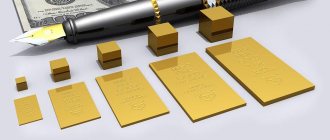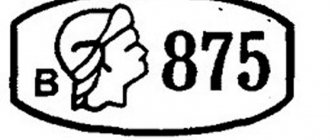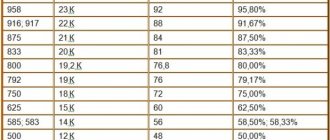►
watch video
►
read educational program for investors
►
buy investment gold
So, an ounce used by banks and jewelers is a measure of weight equal to 31.1034768 grams, which corresponds to 480 grains (a pharmaceutical unit of measurement) or 1/12 of a troy pound (not to be confused with the traditional British pound). The troy ounce also has its official international designation - “oz t”.
Troy ounce in grams - what is it, how much is it, what metals are measured, types of ounces
The ounce is used by different countries to estimate body weight. And the concept of troy is primarily used when indicating the weight of precious metals. On the stock exchange, this measure denotes the mass of only precious metals: gold, silver, palladium and platinum.
Sometimes it is used to estimate the weight of medications and in the production of cosmetics (to estimate the proportions of the components used).
In 1 kilogram - 32.1507466 ozt.
Troy ounce is a unit of measurement for the weight of gold.
An ounce of gold: cost, what it means and where it is used
Why is an ounce of gold currently used to estimate mass (is it applicable to other precious metals)? Indirectly, this simplifies calculations for traders. One basic lot on the exchange weighs 100 ozt, which is now approximately 150 - 160 thousand dollars. One minimum asset to purchase is approximately $1.07 – $1.08. And with a leverage of 1:100, the purchase price of one lot will be about $1,500.
Using recalculation in practice
The need to convert ounce to gram arises, in most cases, when trying to calculate how much gold or silver costs per gram in national currency, for example in rubles, today. The calculation algorithm is quite complex and requires knowledge not only of the cost of the metal in dollars per ounce, but also of the ruble/dollar exchange rate. It looks like this:
the cost of gold (USD/ozt) divided by 31.1035 and multiplied by the exchange rate USD/RUB, we get the price of gold in RUB/g.
There is a calculator for calculating the cost of gold, which makes calculations based on data from the Central Bank, which makes it much easier and faster to get the desired result.
You can find a large number of unit converters on the Internet; when using such programs to convert the weight of precious metals, it is important to remember that you need a troy ounce, and not some other unit.
I hope this article helped to understand the question: 1 ounce, how many grams. Also, when determining value in jewelry, questions often arise related to another obscure unit for determining mass - the carat. You can read the article about this: 1 carat, how many grams.
Why is it important to distinguish between troy and regular ounces?
The names can be confused, but these measures have different meanings. A regular ounce weighs 28.35 grams. Using a simple mathematical formula, you can determine that the weight of a troy is 9.7% more than usual. The difference may seem insignificant. But if we are talking about trading, where the transaction amount, taking into account leverage, can be 1000 XAU, then the difference would be 1 kg of gold. And this is a huge difference in the estimated value of assets! On exchanges, a trader’s income can be generated from a purchase/sale difference of only 0.5%.
There are unscrupulous sellers who sell scrap precious metals, indicating its weight in ordinary ounces. If the buyer does not clarify this nuance, he may overpay the same 9.7%.
Gold bars
Ounce in troy weights and measures
Gold, as the most popular of metals, is often measured using this unit. But the union is not the only “troy” measure of its kind - there are troy pound and grain. The smallest weight is gran, which means “grain” - 64.79892 mg. A troy ounce is 480 times larger in grams.
How much does a troy pound weigh? It is 12 times the value of an ounce, and if rounded to whole numbers, it is equal to 373 g.
Unlike other units of measurement in the system, the ounce is used constantly to measure gold. Today, not a single banking institution that sells elite gold coins can do without it. When weighing medications, pharmacists use the same units in grams as in the troy counting system.
Formula to convert grams of gold or silver to troy ounces
To independently convert the weight of gold into ozt, use the following formula:
X/31.1034768=OZT
where X is the mass of XAU in grams, OZT is the number of troy ounces.
If it is necessary to find out the specific gravity of the ingot, for example 585 p, then the resulting value of troy ounces is multiplied by 0.585.
Alloy of gold and silver
History of measuring the weight of gold in ancient times
How to measure the weight of a product so that neither the seller nor the buyer is deceived?
Places like Karachi, New Delhi, Pakistan, Mumbai, Singapore and Nepal use the Tola system to weigh gold. Tola means weight and the name has its roots in Sanskrit. It weighs 3/8 troy ounce or 180 grains.
Ancient Babylon and the Sumerians gave a weight system consisting of shekels, minas and talents (1 talent consisted of 60 minas, and a mina consisted of 60 shekels). This weight system migrated first to Ancient Greece, and then to the Roman Empire, where the Roman talent already consisted of 100 pondus - pound (translated from Latin - weight). Each pondus consisted of 16 ounces (from the Latin uncia).
Calculator for conversion to t oz
You can use online calculators to convert weight. They are mostly available on stock exchange websites. Also, this “tool” is integrated into the interface of Metatrader 4 and 5 versions (the program through which a trader conducts trading on the exchange). There are programs for PCs and mobile phones where this calculator is integrated with the current gold rate.
(function() { var qs,j,q,s,d=document, gi=d.getElementById, ce=d.createElement, gt=d.getElementsByTagName, id=”calconic_”, b=”https://cdn .calconic.com/static/js/"; if(!gi.call(d,id)) { j=ce.call(d,"script"); j.id=id; j.type="text/ javascript"; j.async=true; j.dataset.calconic=true; j.src=b+"calconic.min.js"; q=gt.call(d,"script")[0]; q.parentNode. insertBefore(j,q) } })();
General information
Mass is the property of physical bodies to resist acceleration. Mass, unlike weight, does not change depending on the environment and does not depend on the gravitational force of the planet on which this body is located. Mass m
determined using Newton's second law, according to the formula:
F
=
m a
, where
F
is force and
a
is acceleration.
Mass and weight
The word “weight” is often used in everyday life when people talk about mass. In physics, weight, in contrast to mass, is a force acting on a body due to the attraction between bodies and planets. Weight can also be calculated using Newton's second law: P
=
m g
, where
m
is the mass and
g
is the acceleration due to gravity. This acceleration occurs due to the gravitational force of the planet near which the body is located, and its magnitude also depends on this force. The acceleration of free fall on Earth is 9.80665 meters per second, and on the Moon it is approximately six times less - 1.63 meters per second. Thus, a body weighing one kilogram weighs 9.8 newtons on Earth and 1.63 newtons on the Moon.
Moon mass 7.3477×10²² kg
Gravitational mass
Gravitational mass shows what gravitational force acts on a body (passive mass) and with what gravitational force the body acts on other bodies (active mass). With an increase in active gravitational mass
body, its force of attraction also increases. It is this force that controls the movement and location of stars, planets and other astronomical objects in the universe. Tides are also caused by the gravitational forces of the Earth and Moon.
With increasing passive gravitational mass
the force with which the gravitational fields of other bodies act on this body also increases.
Inert mass
Inertial mass is the property of a body to resist movement. It is precisely because a body has mass that a certain force must be applied to move the body from its place or change the direction or speed of its movement. The greater the inertial mass, the greater the force required to achieve this. Mass in Newton's second law is precisely inertial mass. The gravitational and inertial masses are equal in magnitude.
Mass and relativity
According to the theory of relativity, gravitating mass changes the curvature of the space-time continuum. The greater the mass of a body, the stronger the curvature around this body, therefore, near bodies of large mass, such as stars, the trajectory of light rays is bent. This effect in astronomy is called gravitational lenses. On the contrary, far from large astronomical objects (massive stars or their clusters called galaxies), the movement of light rays is linear. The main postulate of the theory of relativity is the postulate about the finiteness of the speed of propagation of light. Several interesting consequences follow from this. Firstly, one can imagine the existence of objects with such a large mass that the second cosmic velocity of such a body will be equal to the speed of light, i.e. no information from this object will be able to reach the outside world. Such cosmic objects in the general theory of relativity are called “black holes” and their existence has been experimentally proven by scientists. Secondly, when an object moves at near-light speed, its inertial mass increases so much that local time inside the object slows down compared to time. measured by stationary clocks on Earth. This paradox is known as the “twin paradox”: one of them goes into space flight at near-light speed, the other remains on Earth. Upon returning from the flight twenty years later, it turns out that the twin astronaut is biologically younger than his brother!
Historical chronicles of the origin of the troy ounce and its international significance
All historical sources consider the city of Troyes, the province of Champagne in France, to be the place where this measure of weight appeared, which in the 14th century was a major trading city approved for use by the Count of Troyes - Thibault the Great.
Then this simplified settlements between traders from different countries.
It was used not only to estimate the mass of precious metals, but also products (spices, grains). The concept of a “fluid” ounce was also introduced, corresponding to a volume of 31.103 ml (now practically not used).
Gold jewelry, bracelets
Then the measure began to be actively used by bankers, jewelers and far beyond the borders of France. It was not approved by law; it became the gold standard for measurement much later on the initiative of traders and buyers.
INTERESTING! Troyes is located in the historical region of Champagne, which became famous throughout the world for its winemaking. And “champagne” was invented here. According to legend, it was obtained quite by accident: due to the local climate, the grapes ripened quickly. Therefore, it had a lot of sugar and low acidity. This led to the fact that when aging wines they turned out to be sparkling (the fermentation process started).
Historical unit of weight for jewelers and more
The name "Troy" was borrowed from trades near Champagne, in France. In the village of Troyes, trade was so active that over time the residents had a need to acquire their own unit of measurement of scales to clarify the cost of products. Taking as a basis the national currency of that time - the French livre, which included an ounce of silver, Troyes became the ancestor of a popular weight unit.
Initially, traders used a troy ounce of gold to measure grain crops and medicines - essential goods for all segments of the French population. Later, what a troy ounce was was learned not only in other regions of the country, but throughout the world, and the convenient weight “category” appealed to both jewelers and bankers.
The first official mention of the troy ounce (how many grams, designation and decoding of the concept) is given in the Great Oxford Dictionary of the 14th century. It states that a troy ounce is “a unit of measurement for precious metals and valuable medicines, as well as other goods, used to facilitate trade and settlements with customers, equal to 31.1034768 grams.”
Historians claim that during the Roman Empire, the system of weights and measures contained a value close to the modern troy ounce. The weight of the unit was closer to 28 g and more like the avoirdupois ounce used in England.
Ounce is mistakenly attributed to origin from the large city of "Troy", notorious to lovers of history and tales of heroes of the past. Contrary to popular belief, it has nothing to do with the Trojan Horse or the legends of that time.
What other ounces are there?
The term itself takes its roots in Ancient Rome. There it meant 1/12 of something: weight, length, volume, size. Due to the fact that Rome was one of the key points of international trade, the “ounce” as a measure of weight began to be used everywhere. Its approximate weight has always been about 30 grams (the exception is the Dutch metric ounce).
Currently, only the usual (international) one is used by those countries where the English counting system is adopted, as well as the troy one.
In the system of measures there is still a “fluid” ounce. There are 2 variations of it: American (29.51 ml) and English (28.41 ml), which, however, are now practically not used anywhere.
Translation problems
Translation problems arise due to the presence of different names depending on the field of use and the country where it is used. Adding to the confusion is the fact that some countries, such as the United States, still do not use the metric system, preferring the traditional one.
- Avoirdupois (oz or oz at) – 28.35 g, used by the USA as a measure of weight.
- Fluid ounce (fl oz) – 29.573 531 ml, used to determine the volume of liquid.
- Troy ounce (toz or ozt) – 31.1034768 g, this value is used throughout the world to measure the weight of precious metals.
Use of the universal unit of measurement today and its designation on the stock exchange
The official designation for a troy ounce is ozt. The exchange simply uses the index “X”. In other words, if there is an X in front of the asset index, this means that it is calculated in troy ounces (for example, XAU, XAG).
Ounces also indicate the weight of gold bars and collectible coins, which makes them more accessible to foreign investors and numismatists.
Gold bars with hallmark
Modern weight coins
The weight and purity of gold coins can be divided into two categories. The first is historical or everyday coins made of precious metal. The second includes those intended for investment purposes along with bullion.
Such coins are minted in accordance with the troy weight system and the following values are traditional for them:
- 1/10 t oz;
- ¼ t oz;
- ½ t oz;
- 1 t oz.
Gold Krugerrand
Minted at the South African Mint. In 1980, it accounted for 90% of all world gold coins. The name itself is a combination of the person's name on the front side and the unit of South African currency. In the 1870s. and 1980s. years, some countries banned the import of the Krugerrand due to links with apartheid South Africa. Now the coin is popular among collectors and investors.
Kruger rand production levels have varied considerably over half a century. In the first years, 40 thousand coins were minted, in 1970 the issue increased to 200 thousand copies and continued to grow. In total, approximately six million Krugerrands were produced.
The coin was developed as a means of private investment in gold, was sold equivalent to its price and had no face value, but had the status of legal tender. In addition to the ounce Krugerrand, small coins were minted in half and quarter and tenth oz t. The emission contains about 46 million ozt of gold (about 1500 tons). The Krugerrand's success prompted a reaction from other government mints, which also began minting coins on a fractional ounce basis.
Maple Leaf
Produced by the Royal Canadian Mint since 1979. Face value: 50 Canadian dollars. The market value varies depending on the price of gold. Its purity sometimes reaches 99.999%.
In addition to standard denominations, it is produced in weights of 1/25 and 1/20 t oz. The obverse and reverse feature a profile of Elizabeth II and a Canadian maple leaf. In 2007, the Royal Canadian Mint introduced a coin with a face value of $1 million with a gold price of $2 million. Its diameter was 50 cm, a thickness of 3 cm and a weight of 100 kg.
Chinese panda
A series of coin bars issued by the People's Republic of China. A Chinese mint official introduced a gold panda coin in 1982. The design has changed every year since then.
This coin comes in a variety of sizes and variations ranging from 1/20 t oz to 1 t oz. There are also a number of silver coins with the same characteristics. There are “Giant Panda” coins weighing 5 and 12 t oz.
American eagle
Produced since 1986 in 1/10, ¼, ½ and 1 t oz weights. The actual weight of gold indicated is guaranteed by the US government. The silver content of the alloy is 3%, which makes the coin not as red as the Krugerrand.
22 carat gold alloy (916 hallmark) is traditional English gold. It has not been used on US coins since 1834. By 1837, the gold content of the coin alloy had dropped to 90%. By the time the American Eagle appeared, the content had increased again to 91.67%.
Australian nugget
Minted by the Perth Mint, introduced by a company wholly owned by the Australian Government. Denominations were produced in 1/20, 1/10, ¼, ½, 1, 2, 10 oz and 1 kg of 99.99% gold. They have legal tender status in Australia. An annual limited edition with an original design makes the Australian Nugget a collector's item.
It has two unique features: a two-tone effect due to the rough matte and glossy surfaces and a custom hard encapsulation that protects the coin from impacts and scratches. These features were unusual for standard gold coins and allowed the Nugget to carve out a unique niche in the market.
Austrian Philharmonic (philharmoniker)
The coin has been minted in 99.99% pure gold since 1989. Issued annually in four denominations, sizes and weights. Legal as a means of payment in Austria, after circulation it inevitably ends up in private collections. According to the World Gold Council, it was the most traded coin in the world in 1932, 1995 and 1996. Produced in a weight of 1 t oz and a denomination of 100 euros.
On the reverse side there is a set of musical instruments representing the Vienna Philharmonic, on the reverse there is a large organ of the concert hall. The denomination of Philharmonikers is indicated in shillings (until 2002) or euros. The weight, purity of the alloy and year of manufacture are also indicated. Since 2008, not only gold, but also silver Philharmonic coins have been minted. Their design is identical to the gold coin except for the stated nominal value of 1.5 euros.
It is obvious that the minting of weight coins not only has not died, but is also experiencing a rebirth. Investors around the world buy and sell gold in troy ounces, so the idea of purchasing legal tender multiples of ozt values will always be attractive.
The cost of an ounce of gold in 2014-2015
The year 2013 was remembered among traders and participants in international trading for the sharp fall in the gold rate. Most analysts associate this with the events in Cyprus (a financial crisis related to the country’s debt obligations, which arose against the backdrop of a significant tilt of the state economy in an offshore direction). And indirectly this is the consequences of the 2008 World Economic Crisis. Then, in just 1 day, the price of gold fell by almost 28% (to 1,350 US dollars per ozt).
In 2014, there was a gradual stable increase in the exchange rate up to 1400 USD. July 2015 was marked by the fact that the rate collapsed again to its 5-year low (to 1080 USD), which was caused by a tightening of US monetary policy (we are talking about an increase in the interest rate). But then, as expected, the rate rapidly went up.
The coronavirus pandemic also had a significant impact on the price, as demand for XAU increased sharply (as the most stable asset for investors). July 2021: the rate exceeded the 2000 USD mark for the first time in history.
At the beginning of 2021, the rate is 1700 USD.
INTERESTING! The current analyst forecast indicates that the XAU price chart will gradually increase. Therefore, it is not worth selling gold assets until 2025–2027.
Who today determines the cost of one troy ounce?
The price for one troy ounce of gold is set by one of the oldest trading platforms in the world: the London Metal Exchange. Price fixing - the well-known London fixing - occurs twice a day: at 10:30 and in the afternoon, at 15:00 London time. The London Stock Exchange determines the price of gold based on the results of two trading sessions, which are held from 11:40 to 14:45 and from 14:55 to 17:00.
The price of gold on the London Stock Exchange plays a decisive role in setting the price of precious metals on world exchanges, and also serves as an indicator of the state of the world economy. Based on these data, analysts make assumptions regarding exchange rates and the value of various minerals on the world market.
Recently, the price of gold has been rising. Since March 2021, its price has increased by more than 21%. Amid the pandemic and the weakening dollar, investors are investing in the precious metal because they consider it the safest asset.
Variations in the cost of an ounce of gold, taking into account markups
The average consumer cannot buy 1 ounce of silver or gold. Trade in precious metals among individuals is generally prohibited by law in many countries. This does not apply to jewelry made from precious metals. When purchasing, the price of gold will be significantly higher than the current exchange rate. After all, they add to the cost:
- jeweler's work;
- trade markup of a jewelry store.
The final price is approximately 40% higher than the exchange price. The highest markup is in collectible coins, up to 1000%.
INTERESTING! The florin of Edward III is now considered the most expensive coin. Three such specimens are known to exist. Its estimated value for auctions is $6.8 million. But until today, none of the auction houses had put it up for sale.
The most expensive florin coin of Edward III
London fixing and price per ounce
The number of people wishing to make money on precious metals quotes is growing every day, and this is no coincidence: gold, unlike reserve currencies, is a highly liquid asset that is characterized by constancy. As of April 1, 2021, an ounce of gold was equivalent to 1251.4 US dollars. The first mention of setting prices per ounce in the troy system dates back to 1790 - then in the United States they asked for a little more than $19.
Traditionally, gold fixing is set by the London Stock Exchange twice a day. You can track your indicators online. In the Russian Federation, Sberbank and the Central Bank daily publish data on changes in quotations of currencies and precious metals.
Interesting statistics: according to analysts’ calculations, the growth in the cost of precious metals is influenced not only by economic indicators within states and the foreign policies of countries, but also by the psychological situation. Donald Trump's statements in December this year contributed to the positive dynamics of gold prices. The status as of March 3, 2021 characterizes the average monthly price of the precious metal.
Areas of application of the troy ounce other than the precious metals exchange
In addition to stock trading, the measure is used in the following areas:
- Jewelry industry. In many countries, jewelry stores indicate the weight of products exclusively using ozt.
- Banking. When assessing the weight of ingots and describing them, the mass is always indicated exactly by ozt (or fractional parts of it).
- Production of cosmetics and pharmaceutical products. Used to indicate the specific gravity of a particular component.
Convert oz to grams
It is worth noting that the ounce has the international designation oz. 1 ounce is currently 28.349523 grams. The value of this value changes twice a day and depends on the London fixing rate.
Of course, in the modern world there are a huge number of currency converters that can easily help you convert one value into another. We are pursuing another goal - to learn how to independently convert these values. This way we can find out how many grams an ounce is.
The formula for calculation will be as follows: (? oz) * (1 lb/16 oz) * (1 kg / 2.2046 lb) * (1000 g / 1 kg) =
To calculate how many grams are in ounces, you need to substitute the value you are interested in. So, 1 ounce in grams will be:
1oz * (1lb/16 oz) * (1 kg/2.2046 lb) * (1000g/1 kg) = 28.349814g
You may be interested in: How to distinguish gold from gilding?
Four ounces:
4oz * (1lb/16 oz) * (1 kg/2.2046 lb) * (1000g/1 kg) =113.396041g
5 oz:
5oz * (1lb/16 oz) * (1 kg/2.2046 lb) * (1000g/1 kg) =141.749070g
9 oz:
9oz * (1lb/16 oz) * (1 kg/2.2046 lb) * (1000g/1 kg) =255.148326g
This method is one of the most accurate; it will easily help you find out how many grams are contained in a particular quantity of oz, thereby showing the weight of an ounce.
In addition to this method, the table will help you find out how much one tenth or more of an ounce contains:
| oz | gr. | oz | gr. | oz | gr. | oz | gr. | oz | gr. | oz | gr. | oz | gr. | oz | gr. | oz | gr. |
| 1/2 | 14.18 | 2/3 | 18.99 | 3/4 | 21.26 | 4/5 | 22.68 | 5/6 | 23.53 | 6/7 | 24.38 | 7/8 | 24.95 | 8/9 | 25.3 | 9/10 | 25.52 |
| 1/3 | 9.44 | 2/5 | 11.34 | 3/5 | 17.01 | 4/7 | 16.16 | 5/7 | 20.13 | 6/11 | 15.46 | 7/9 | 22.11 | 8/11 | 20.62 | 9/11 | 23.2 |
| 1/4 | 7.09 | 2/7 | 8.22 | 3/7 | 12.19 | 4/9 | 12.47 | 5/8 | 17.86 | 6/13 | 13.08 | 7/10 | 19.85 | 8/13 | 17.45 | 9/13 | 19.63 |
| 1/5 | 5.67 | 2/9 | 6.24 | 3/8 | 10.77 | 4/11 | 10.31 | 5/9 | 15.88 | 6/16 | 10.63 | 7/11 | 18.04 | 8/15 | 15.12 | 9/14 | 18.23 |
| 1/6 | 4.82 | 2/11 | 5.15 | 3/10 | 8.51 | 4/13 | 8.72 | 5/11 | 12.89 | 6/17 | 10 | 7/12 | 16.54 | 8/17 | 13.34 | 9/17 | 15.95 |
| 1/7 | 3.97 | 2/13 | 4.36 | 3/11 | 7.73 | 4/14 | 8.1 | 5/12 | 11.81 | 6/19 | 8.95 | 7/13 | 15.27 | 8/19 | 11.94 | 9/20 | 15.01 |
| 1/8 | 3.69 | 2/15 | 3.78 | 3/13 | 6.54 | 4/15 | 7.56 | 5/13 | 10.9 | 6/25 | 6.8 | 7/15 | 13.23 | 8/21 | 10.8 | 9/25 | 12.76 |
| 1/9 | 3.12 | 2/17 | 3.34 | 3/14 | 6.08 | 4/17 | 6.67 | 5/14 | 10.12 | 6/35 | 4.86 | 7/16 | 12.4 | 8/25 | 9.07 | 9/35 | 10.21 |
| 1/10 | 2.83 | 2/19 | 2.98 | 3/16 | 5.32 | 4/18 | 6.3 | 5/21 | 6.75 | 6/45 | 3.78 | 7/17 | 11.67 | 8/31 | 7.32 | 9/40 | 7.29 |
| 1/11 | 2.58 | 2/21 | 2.7 | 3/17 | 5 | 4/19 | 5.97 | 5/31 | 4.57 | 6/55 | 3.09 | 7/18 | 11.03 | 8/41 | 5.53 | 9/50 | 6.38 |
| 1/12 | 2.36 | 2/25 | 2.27 | 3/19 | 4.48 | 4/21 | 5.4 | 5/41 | 3.46 | 6/65 | 2.61 | 7/19 | 10.45 | 8/51 | 4.45 | 9/60 | 5.1 |
| 1/13 | 2.18 | 2/31 | 1.83 | 3/20 | 4.25 | 4/25 | 4.54 | 5/51 | 2.78 | 6/75 | 2.27 | 7/20 | 9.92 | 8/61 | 3.72 | 9/70 | 4.25 |
| 1/14 | 2.03 | 2/41 | 1.38 | 3/25 | 3.4 | 4/35 | 3.24 | 5/61 | 2.32 | 6/85 | 2 | 7/25 | 7.94 | 8/71 | 3.19 | 9/80 | 3.65 |
| 1/15 | 1.89 | 2/51 | 1.11 | 3/35 | 2.43 | 4/45 | 2.52 | 5/71 | 2 | 6/95 | 1.79 | 7/30 | 6.62 | 8/81 | 2.8 | 9/90 | 3.19 |
| 1/16 | 1.77 | 2/61 | 0.93 | 3/40 | 2.13 | 4/55 | 2.06 | 5/81 | 1.75 | 7/40 | 4.96 | 8/91 | 2.49 | 9/100 | 2.55 | ||
| 1/17 | 1.67 | 2/71 | 0.8 | 3/50 | 1.7 | 4/65 | 1.75 | 5/91 | 1.56 | 7/50 | 3.97 | ||||||
| 1/18 | 1.58 | 2/81 | 0.7 | 3/70 | 1.22 | 4/75 | 1.51 | 7/60 | 3.31 | ||||||||
| 1/19 | 1.49 | 2/91 | 0.62 | 3/80 | 1.06 | 4/85 | 1.33 | 7/80 | 2.48 | ||||||||
| 1/20 | 1.42 | 2/99 | 0.57 | 3/100 | 0.85 | 4/95 | 1.19 | 7/90 | 2.21 | ||||||||
| 1/25 | 1.13 | 7/100 | 1.98 | ||||||||||||||
| 1/30 | 0.95 | ||||||||||||||||
| 1/40 | 0.71 | ||||||||||||||||
| 1/50 | 0.57 | ||||||||||||||||
| 1/60 | 0.47 | ||||||||||||||||
| 1/70 | 0.41 | ||||||||||||||||
| 1/80 | 0.35 | ||||||||||||||||
| 1/90 | 0.32 | ||||||||||||||||
| 1/100 | 0.28 |
You may be interested in: What does the mark on gold jewelry mean?
Measure in different countries
The value of ozt in different countries is close to troy, but still differs. Known variations:
| Option | Weight (grams) |
| International | 28,349523125 |
| Dutch metric | 100 |
| Portuguese | 28,69 |
| Chinese | 50 |
| Spanish | 28,75 |
| Ancient Roman | 28,34 |
| English (tower) | 29,1595095 |











